Auditing and Professional Practice
VerifiedAdded on 2023/01/16
|8
|1610
|85
AI Summary
This document provides information on auditing and professional practice. It includes a scenario with threats, analysis of threats to compliance with the IFAC code, and requirements for issuing different types of audit opinions. The document also includes references for further reading.
Contribute Materials
Your contribution can guide someone’s learning journey. Share your
documents today.
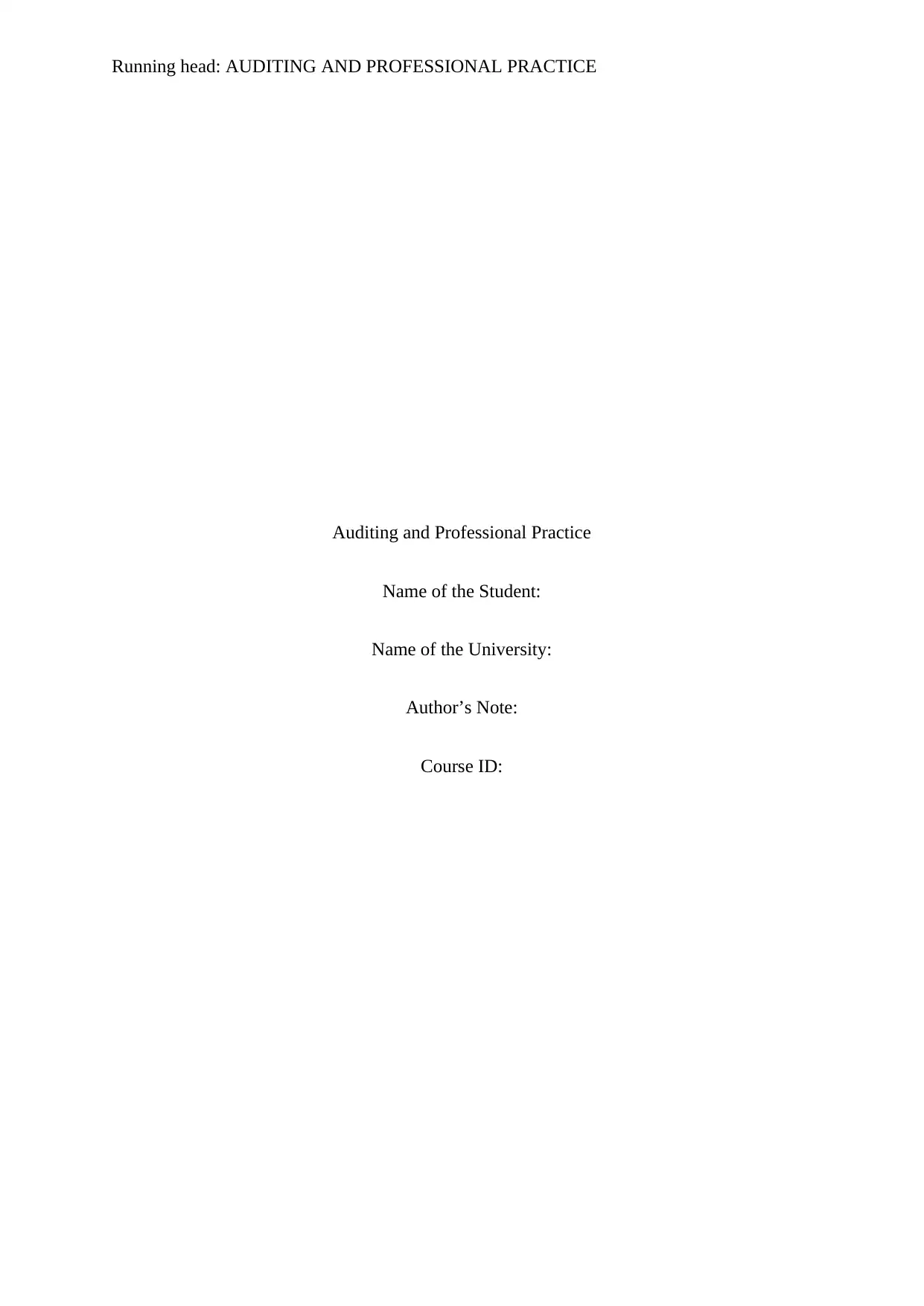
Running head: AUDITING AND PROFESSIONAL PRACTICE
Auditing and Professional Practice
Name of the Student:
Name of the University:
Author’s Note:
Course ID:
Auditing and Professional Practice
Name of the Student:
Name of the University:
Author’s Note:
Course ID:
Secure Best Marks with AI Grader
Need help grading? Try our AI Grader for instant feedback on your assignments.
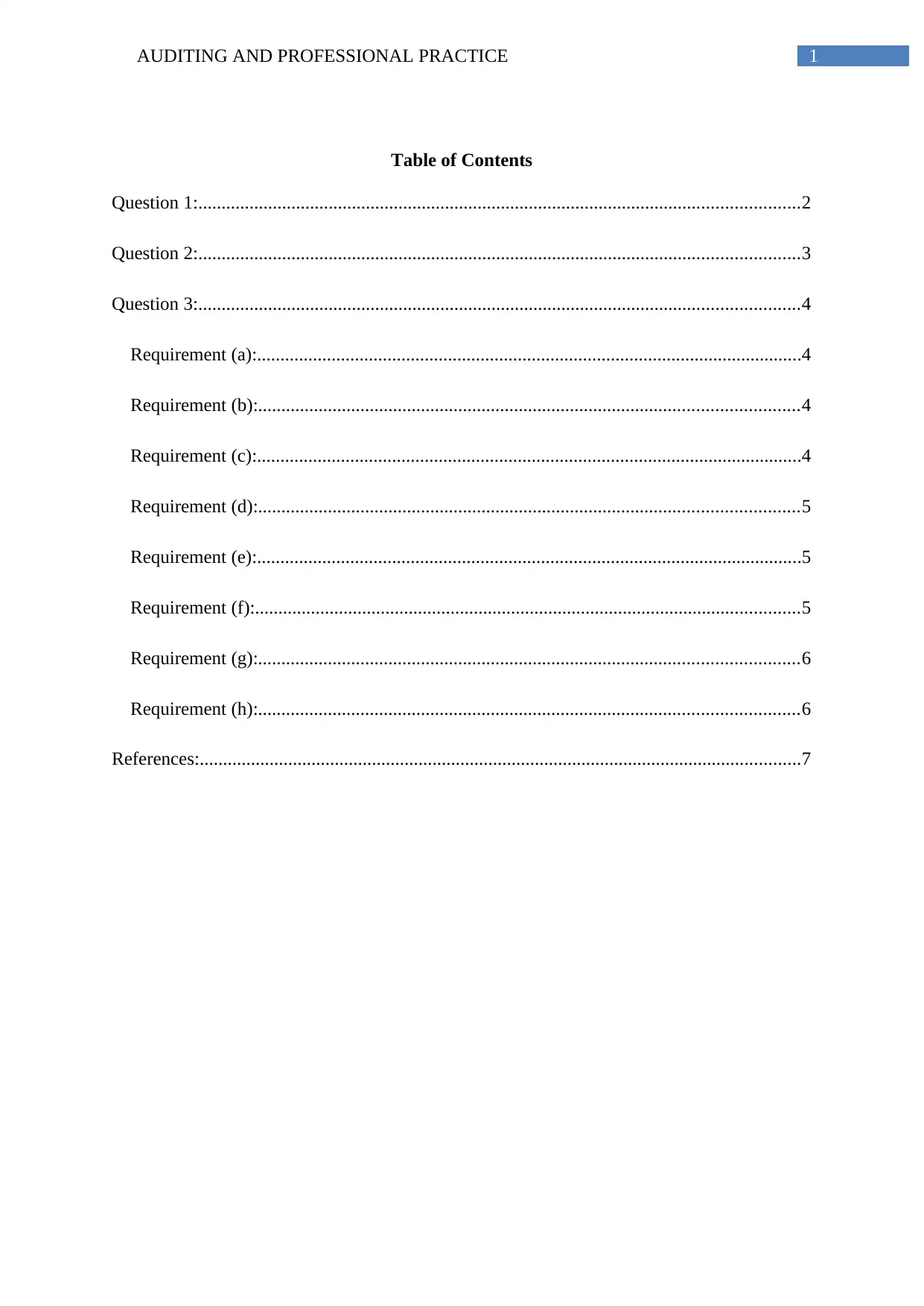
1AUDITING AND PROFESSIONAL PRACTICE
Table of Contents
Question 1:.................................................................................................................................2
Question 2:.................................................................................................................................3
Question 3:.................................................................................................................................4
Requirement (a):.....................................................................................................................4
Requirement (b):....................................................................................................................4
Requirement (c):.....................................................................................................................4
Requirement (d):....................................................................................................................5
Requirement (e):.....................................................................................................................5
Requirement (f):.....................................................................................................................5
Requirement (g):....................................................................................................................6
Requirement (h):....................................................................................................................6
References:.................................................................................................................................7
Table of Contents
Question 1:.................................................................................................................................2
Question 2:.................................................................................................................................3
Question 3:.................................................................................................................................4
Requirement (a):.....................................................................................................................4
Requirement (b):....................................................................................................................4
Requirement (c):.....................................................................................................................4
Requirement (d):....................................................................................................................5
Requirement (e):.....................................................................................................................5
Requirement (f):.....................................................................................................................5
Requirement (g):....................................................................................................................6
Requirement (h):....................................................................................................................6
References:.................................................................................................................................7
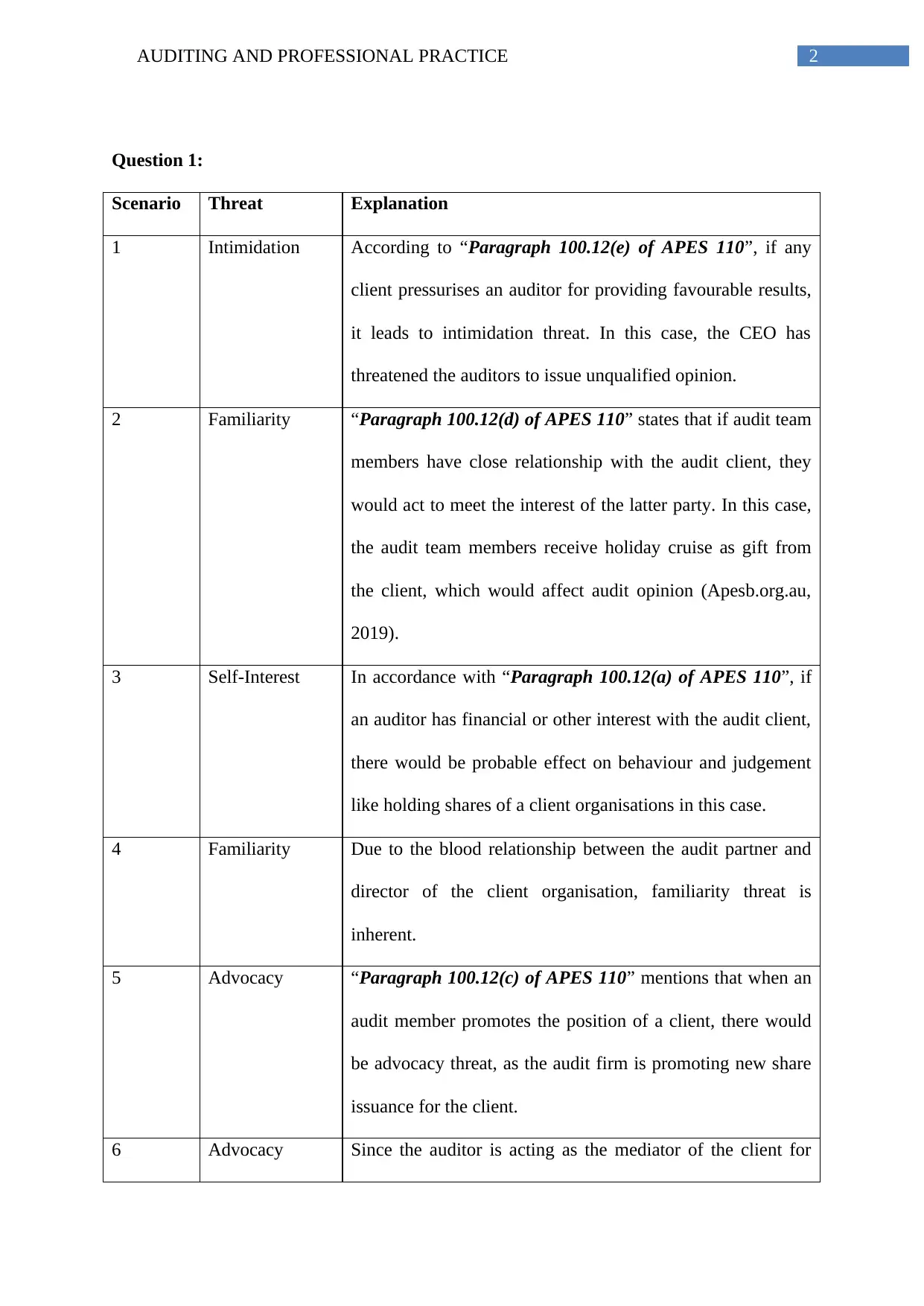
2AUDITING AND PROFESSIONAL PRACTICE
Question 1:
Scenario Threat Explanation
1 Intimidation According to “Paragraph 100.12(e) of APES 110”, if any
client pressurises an auditor for providing favourable results,
it leads to intimidation threat. In this case, the CEO has
threatened the auditors to issue unqualified opinion.
2 Familiarity “Paragraph 100.12(d) of APES 110” states that if audit team
members have close relationship with the audit client, they
would act to meet the interest of the latter party. In this case,
the audit team members receive holiday cruise as gift from
the client, which would affect audit opinion (Apesb.org.au,
2019).
3 Self-Interest In accordance with “Paragraph 100.12(a) of APES 110”, if
an auditor has financial or other interest with the audit client,
there would be probable effect on behaviour and judgement
like holding shares of a client organisations in this case.
4 Familiarity Due to the blood relationship between the audit partner and
director of the client organisation, familiarity threat is
inherent.
5 Advocacy “Paragraph 100.12(c) of APES 110” mentions that when an
audit member promotes the position of a client, there would
be advocacy threat, as the audit firm is promoting new share
issuance for the client.
6 Advocacy Since the auditor is acting as the mediator of the client for
Question 1:
Scenario Threat Explanation
1 Intimidation According to “Paragraph 100.12(e) of APES 110”, if any
client pressurises an auditor for providing favourable results,
it leads to intimidation threat. In this case, the CEO has
threatened the auditors to issue unqualified opinion.
2 Familiarity “Paragraph 100.12(d) of APES 110” states that if audit team
members have close relationship with the audit client, they
would act to meet the interest of the latter party. In this case,
the audit team members receive holiday cruise as gift from
the client, which would affect audit opinion (Apesb.org.au,
2019).
3 Self-Interest In accordance with “Paragraph 100.12(a) of APES 110”, if
an auditor has financial or other interest with the audit client,
there would be probable effect on behaviour and judgement
like holding shares of a client organisations in this case.
4 Familiarity Due to the blood relationship between the audit partner and
director of the client organisation, familiarity threat is
inherent.
5 Advocacy “Paragraph 100.12(c) of APES 110” mentions that when an
audit member promotes the position of a client, there would
be advocacy threat, as the audit firm is promoting new share
issuance for the client.
6 Advocacy Since the auditor is acting as the mediator of the client for
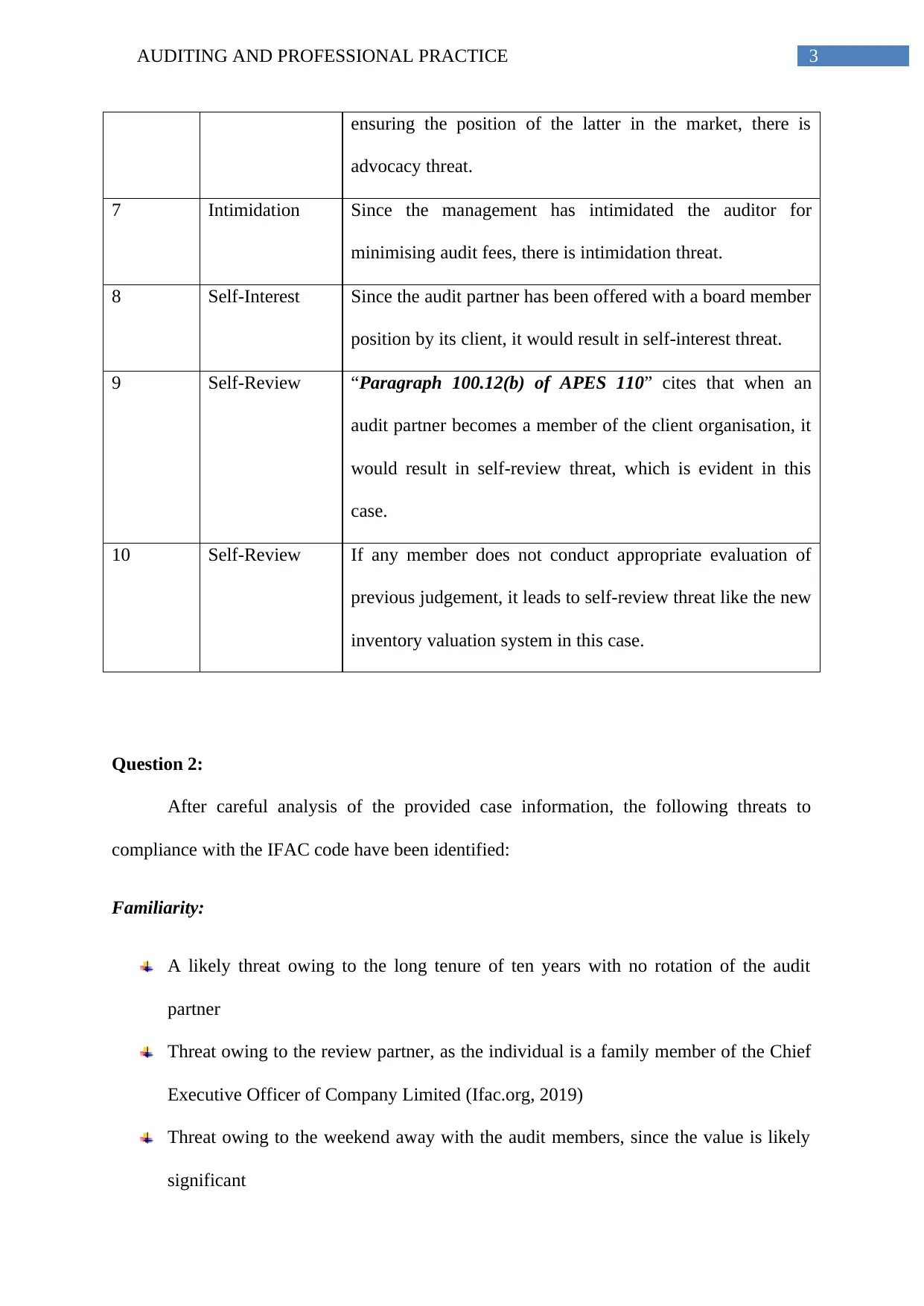
3AUDITING AND PROFESSIONAL PRACTICE
ensuring the position of the latter in the market, there is
advocacy threat.
7 Intimidation Since the management has intimidated the auditor for
minimising audit fees, there is intimidation threat.
8 Self-Interest Since the audit partner has been offered with a board member
position by its client, it would result in self-interest threat.
9 Self-Review “Paragraph 100.12(b) of APES 110” cites that when an
audit partner becomes a member of the client organisation, it
would result in self-review threat, which is evident in this
case.
10 Self-Review If any member does not conduct appropriate evaluation of
previous judgement, it leads to self-review threat like the new
inventory valuation system in this case.
Question 2:
After careful analysis of the provided case information, the following threats to
compliance with the IFAC code have been identified:
Familiarity:
A likely threat owing to the long tenure of ten years with no rotation of the audit
partner
Threat owing to the review partner, as the individual is a family member of the Chief
Executive Officer of Company Limited (Ifac.org, 2019)
Threat owing to the weekend away with the audit members, since the value is likely
significant
ensuring the position of the latter in the market, there is
advocacy threat.
7 Intimidation Since the management has intimidated the auditor for
minimising audit fees, there is intimidation threat.
8 Self-Interest Since the audit partner has been offered with a board member
position by its client, it would result in self-interest threat.
9 Self-Review “Paragraph 100.12(b) of APES 110” cites that when an
audit partner becomes a member of the client organisation, it
would result in self-review threat, which is evident in this
case.
10 Self-Review If any member does not conduct appropriate evaluation of
previous judgement, it leads to self-review threat like the new
inventory valuation system in this case.
Question 2:
After careful analysis of the provided case information, the following threats to
compliance with the IFAC code have been identified:
Familiarity:
A likely threat owing to the long tenure of ten years with no rotation of the audit
partner
Threat owing to the review partner, as the individual is a family member of the Chief
Executive Officer of Company Limited (Ifac.org, 2019)
Threat owing to the weekend away with the audit members, since the value is likely
significant
Secure Best Marks with AI Grader
Need help grading? Try our AI Grader for instant feedback on your assignments.
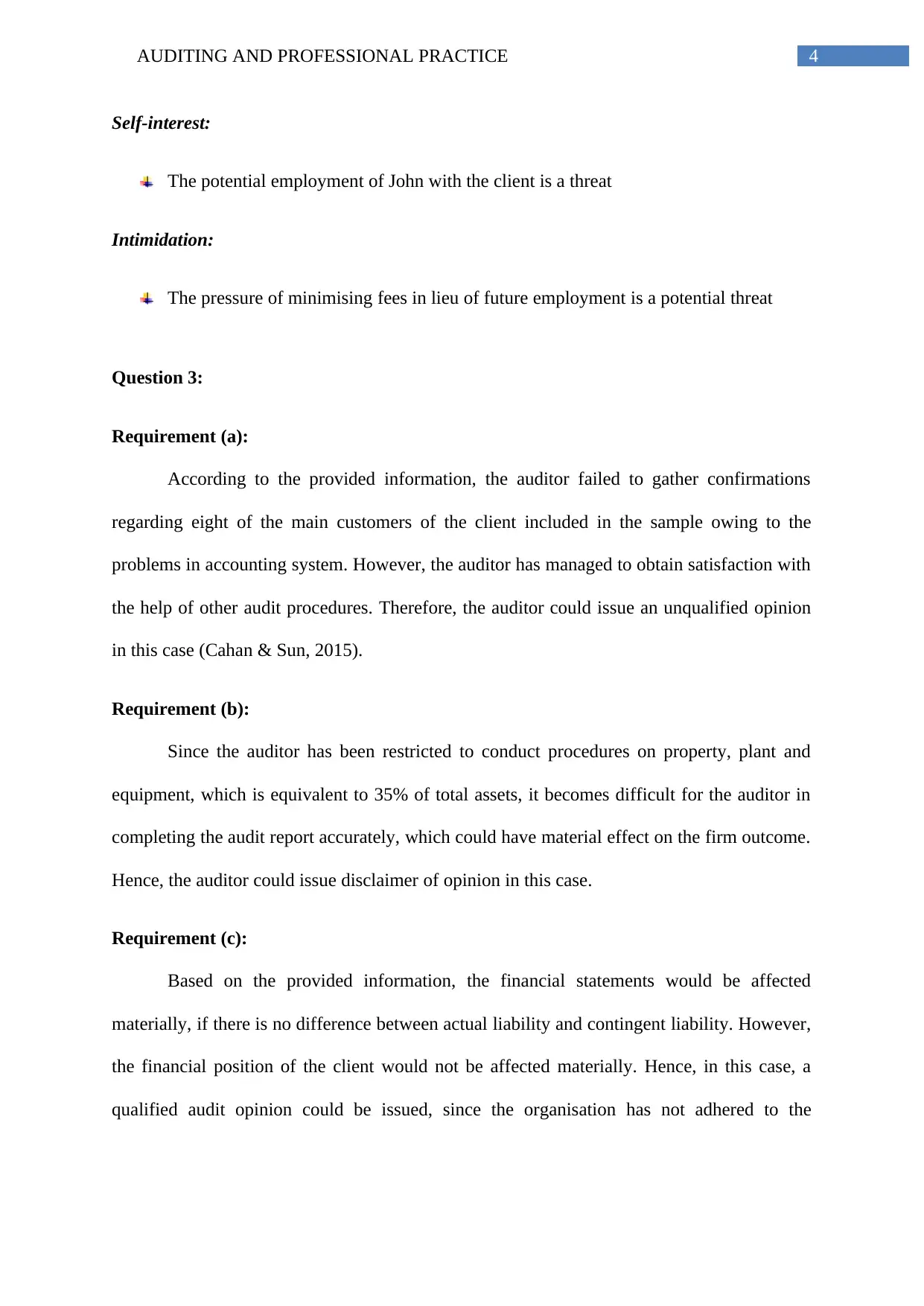
4AUDITING AND PROFESSIONAL PRACTICE
Self-interest:
The potential employment of John with the client is a threat
Intimidation:
The pressure of minimising fees in lieu of future employment is a potential threat
Question 3:
Requirement (a):
According to the provided information, the auditor failed to gather confirmations
regarding eight of the main customers of the client included in the sample owing to the
problems in accounting system. However, the auditor has managed to obtain satisfaction with
the help of other audit procedures. Therefore, the auditor could issue an unqualified opinion
in this case (Cahan & Sun, 2015).
Requirement (b):
Since the auditor has been restricted to conduct procedures on property, plant and
equipment, which is equivalent to 35% of total assets, it becomes difficult for the auditor in
completing the audit report accurately, which could have material effect on the firm outcome.
Hence, the auditor could issue disclaimer of opinion in this case.
Requirement (c):
Based on the provided information, the financial statements would be affected
materially, if there is no difference between actual liability and contingent liability. However,
the financial position of the client would not be affected materially. Hence, in this case, a
qualified audit opinion could be issued, since the organisation has not adhered to the
Self-interest:
The potential employment of John with the client is a threat
Intimidation:
The pressure of minimising fees in lieu of future employment is a potential threat
Question 3:
Requirement (a):
According to the provided information, the auditor failed to gather confirmations
regarding eight of the main customers of the client included in the sample owing to the
problems in accounting system. However, the auditor has managed to obtain satisfaction with
the help of other audit procedures. Therefore, the auditor could issue an unqualified opinion
in this case (Cahan & Sun, 2015).
Requirement (b):
Since the auditor has been restricted to conduct procedures on property, plant and
equipment, which is equivalent to 35% of total assets, it becomes difficult for the auditor in
completing the audit report accurately, which could have material effect on the firm outcome.
Hence, the auditor could issue disclaimer of opinion in this case.
Requirement (c):
Based on the provided information, the financial statements would be affected
materially, if there is no difference between actual liability and contingent liability. However,
the financial position of the client would not be affected materially. Hence, in this case, a
qualified audit opinion could be issued, since the organisation has not adhered to the
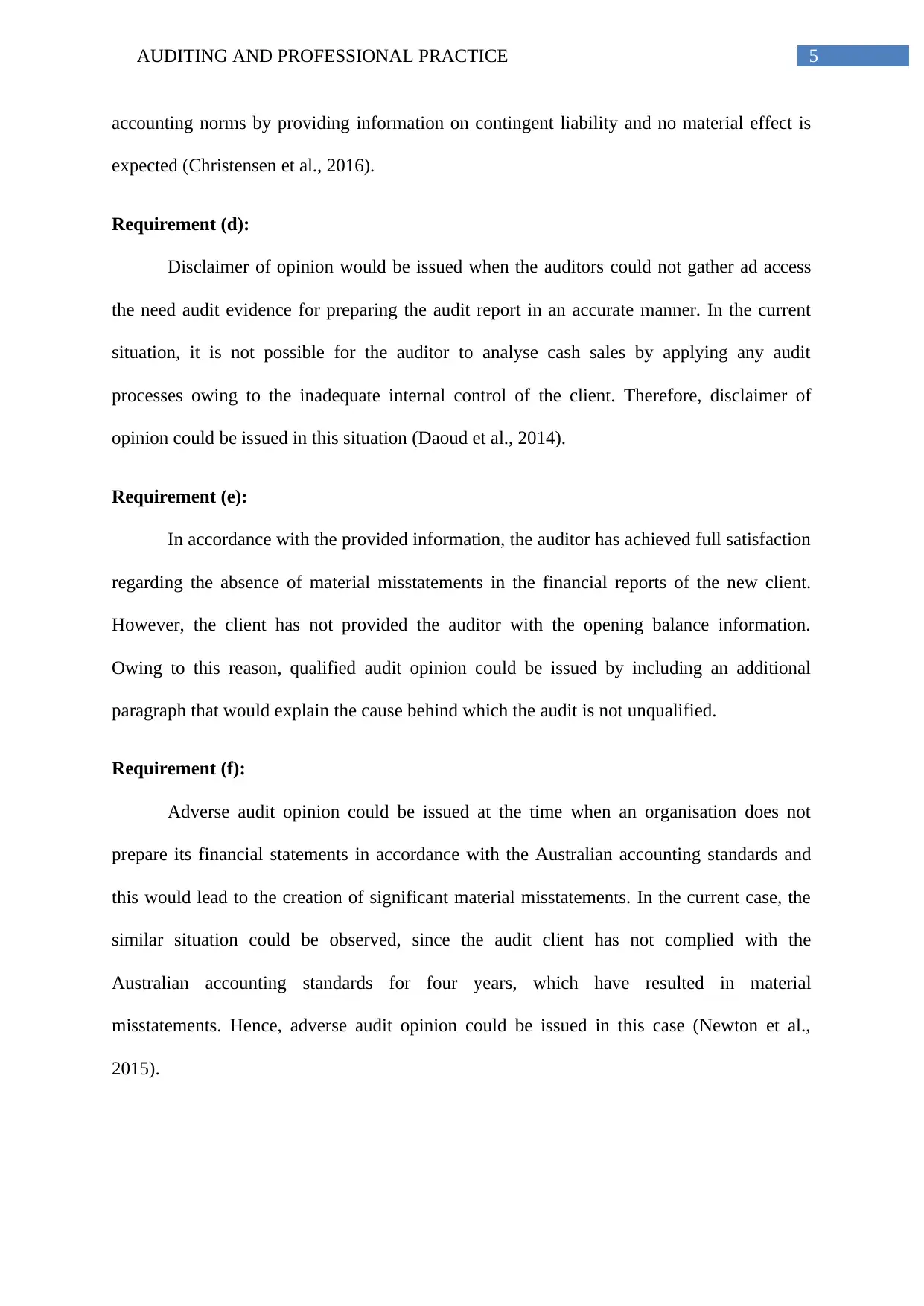
5AUDITING AND PROFESSIONAL PRACTICE
accounting norms by providing information on contingent liability and no material effect is
expected (Christensen et al., 2016).
Requirement (d):
Disclaimer of opinion would be issued when the auditors could not gather ad access
the need audit evidence for preparing the audit report in an accurate manner. In the current
situation, it is not possible for the auditor to analyse cash sales by applying any audit
processes owing to the inadequate internal control of the client. Therefore, disclaimer of
opinion could be issued in this situation (Daoud et al., 2014).
Requirement (e):
In accordance with the provided information, the auditor has achieved full satisfaction
regarding the absence of material misstatements in the financial reports of the new client.
However, the client has not provided the auditor with the opening balance information.
Owing to this reason, qualified audit opinion could be issued by including an additional
paragraph that would explain the cause behind which the audit is not unqualified.
Requirement (f):
Adverse audit opinion could be issued at the time when an organisation does not
prepare its financial statements in accordance with the Australian accounting standards and
this would lead to the creation of significant material misstatements. In the current case, the
similar situation could be observed, since the audit client has not complied with the
Australian accounting standards for four years, which have resulted in material
misstatements. Hence, adverse audit opinion could be issued in this case (Newton et al.,
2015).
accounting norms by providing information on contingent liability and no material effect is
expected (Christensen et al., 2016).
Requirement (d):
Disclaimer of opinion would be issued when the auditors could not gather ad access
the need audit evidence for preparing the audit report in an accurate manner. In the current
situation, it is not possible for the auditor to analyse cash sales by applying any audit
processes owing to the inadequate internal control of the client. Therefore, disclaimer of
opinion could be issued in this situation (Daoud et al., 2014).
Requirement (e):
In accordance with the provided information, the auditor has achieved full satisfaction
regarding the absence of material misstatements in the financial reports of the new client.
However, the client has not provided the auditor with the opening balance information.
Owing to this reason, qualified audit opinion could be issued by including an additional
paragraph that would explain the cause behind which the audit is not unqualified.
Requirement (f):
Adverse audit opinion could be issued at the time when an organisation does not
prepare its financial statements in accordance with the Australian accounting standards and
this would lead to the creation of significant material misstatements. In the current case, the
similar situation could be observed, since the audit client has not complied with the
Australian accounting standards for four years, which have resulted in material
misstatements. Hence, adverse audit opinion could be issued in this case (Newton et al.,
2015).
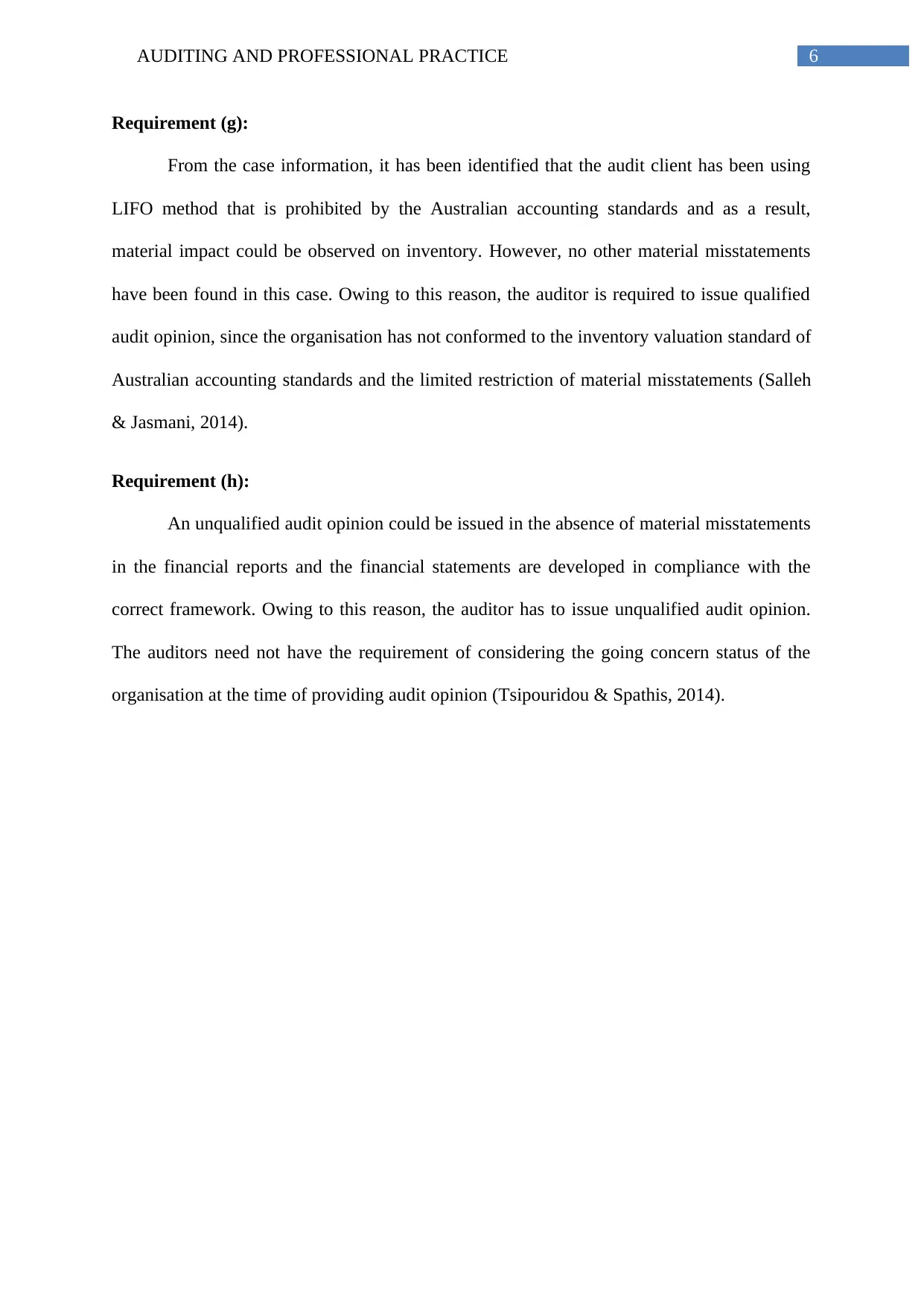
6AUDITING AND PROFESSIONAL PRACTICE
Requirement (g):
From the case information, it has been identified that the audit client has been using
LIFO method that is prohibited by the Australian accounting standards and as a result,
material impact could be observed on inventory. However, no other material misstatements
have been found in this case. Owing to this reason, the auditor is required to issue qualified
audit opinion, since the organisation has not conformed to the inventory valuation standard of
Australian accounting standards and the limited restriction of material misstatements (Salleh
& Jasmani, 2014).
Requirement (h):
An unqualified audit opinion could be issued in the absence of material misstatements
in the financial reports and the financial statements are developed in compliance with the
correct framework. Owing to this reason, the auditor has to issue unqualified audit opinion.
The auditors need not have the requirement of considering the going concern status of the
organisation at the time of providing audit opinion (Tsipouridou & Spathis, 2014).
Requirement (g):
From the case information, it has been identified that the audit client has been using
LIFO method that is prohibited by the Australian accounting standards and as a result,
material impact could be observed on inventory. However, no other material misstatements
have been found in this case. Owing to this reason, the auditor is required to issue qualified
audit opinion, since the organisation has not conformed to the inventory valuation standard of
Australian accounting standards and the limited restriction of material misstatements (Salleh
& Jasmani, 2014).
Requirement (h):
An unqualified audit opinion could be issued in the absence of material misstatements
in the financial reports and the financial statements are developed in compliance with the
correct framework. Owing to this reason, the auditor has to issue unqualified audit opinion.
The auditors need not have the requirement of considering the going concern status of the
organisation at the time of providing audit opinion (Tsipouridou & Spathis, 2014).
Paraphrase This Document
Need a fresh take? Get an instant paraphrase of this document with our AI Paraphraser
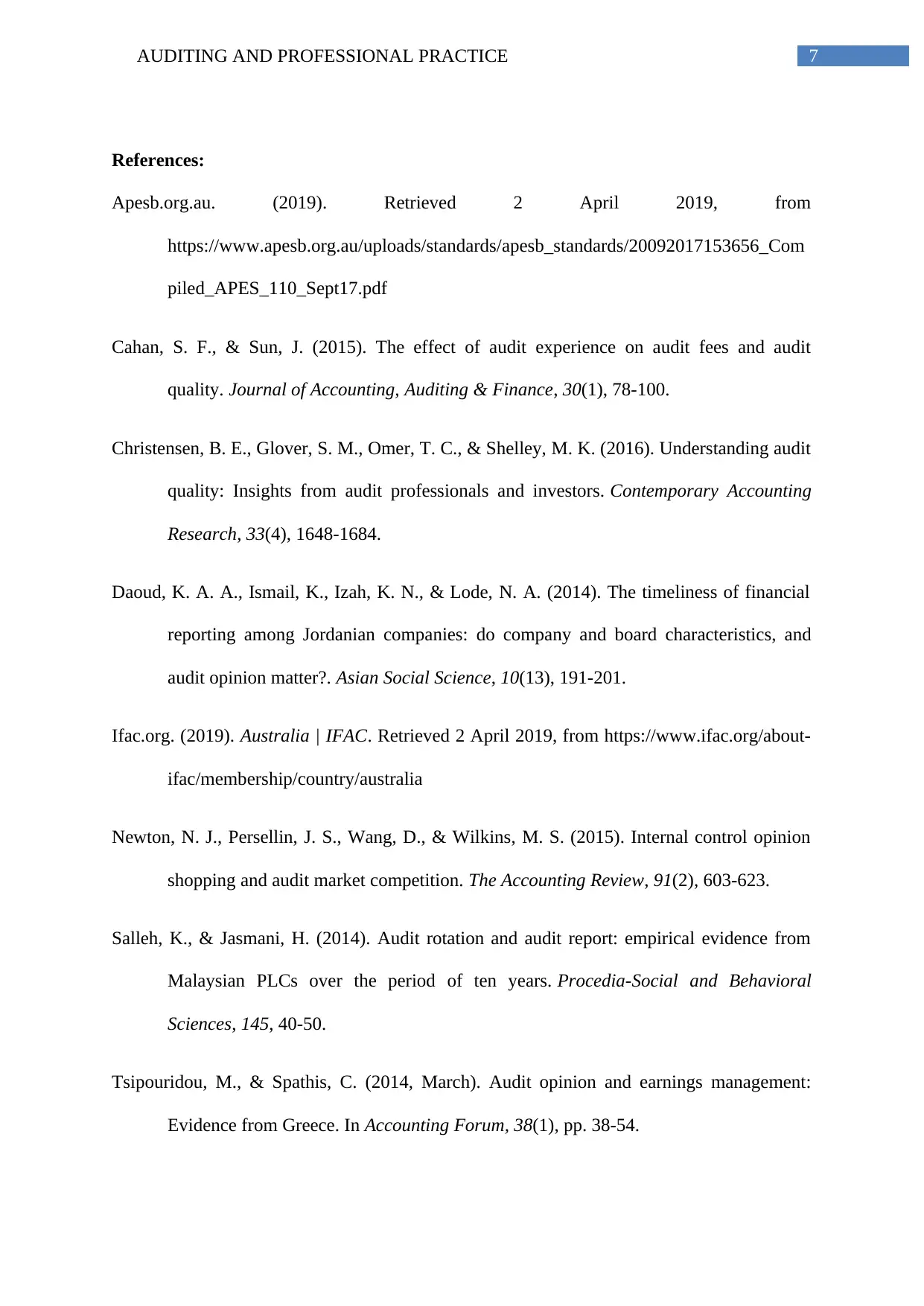
7AUDITING AND PROFESSIONAL PRACTICE
References:
Apesb.org.au. (2019). Retrieved 2 April 2019, from
https://www.apesb.org.au/uploads/standards/apesb_standards/20092017153656_Com
piled_APES_110_Sept17.pdf
Cahan, S. F., & Sun, J. (2015). The effect of audit experience on audit fees and audit
quality. Journal of Accounting, Auditing & Finance, 30(1), 78-100.
Christensen, B. E., Glover, S. M., Omer, T. C., & Shelley, M. K. (2016). Understanding audit
quality: Insights from audit professionals and investors. Contemporary Accounting
Research, 33(4), 1648-1684.
Daoud, K. A. A., Ismail, K., Izah, K. N., & Lode, N. A. (2014). The timeliness of financial
reporting among Jordanian companies: do company and board characteristics, and
audit opinion matter?. Asian Social Science, 10(13), 191-201.
Ifac.org. (2019). Australia | IFAC. Retrieved 2 April 2019, from https://www.ifac.org/about-
ifac/membership/country/australia
Newton, N. J., Persellin, J. S., Wang, D., & Wilkins, M. S. (2015). Internal control opinion
shopping and audit market competition. The Accounting Review, 91(2), 603-623.
Salleh, K., & Jasmani, H. (2014). Audit rotation and audit report: empirical evidence from
Malaysian PLCs over the period of ten years. Procedia-Social and Behavioral
Sciences, 145, 40-50.
Tsipouridou, M., & Spathis, C. (2014, March). Audit opinion and earnings management:
Evidence from Greece. In Accounting Forum, 38(1), pp. 38-54.
References:
Apesb.org.au. (2019). Retrieved 2 April 2019, from
https://www.apesb.org.au/uploads/standards/apesb_standards/20092017153656_Com
piled_APES_110_Sept17.pdf
Cahan, S. F., & Sun, J. (2015). The effect of audit experience on audit fees and audit
quality. Journal of Accounting, Auditing & Finance, 30(1), 78-100.
Christensen, B. E., Glover, S. M., Omer, T. C., & Shelley, M. K. (2016). Understanding audit
quality: Insights from audit professionals and investors. Contemporary Accounting
Research, 33(4), 1648-1684.
Daoud, K. A. A., Ismail, K., Izah, K. N., & Lode, N. A. (2014). The timeliness of financial
reporting among Jordanian companies: do company and board characteristics, and
audit opinion matter?. Asian Social Science, 10(13), 191-201.
Ifac.org. (2019). Australia | IFAC. Retrieved 2 April 2019, from https://www.ifac.org/about-
ifac/membership/country/australia
Newton, N. J., Persellin, J. S., Wang, D., & Wilkins, M. S. (2015). Internal control opinion
shopping and audit market competition. The Accounting Review, 91(2), 603-623.
Salleh, K., & Jasmani, H. (2014). Audit rotation and audit report: empirical evidence from
Malaysian PLCs over the period of ten years. Procedia-Social and Behavioral
Sciences, 145, 40-50.
Tsipouridou, M., & Spathis, C. (2014, March). Audit opinion and earnings management:
Evidence from Greece. In Accounting Forum, 38(1), pp. 38-54.
1 out of 8
Related Documents
Your All-in-One AI-Powered Toolkit for Academic Success.
+13062052269
info@desklib.com
Available 24*7 on WhatsApp / Email
![[object Object]](/_next/static/media/star-bottom.7253800d.svg)
Unlock your academic potential
© 2024 | Zucol Services PVT LTD | All rights reserved.





